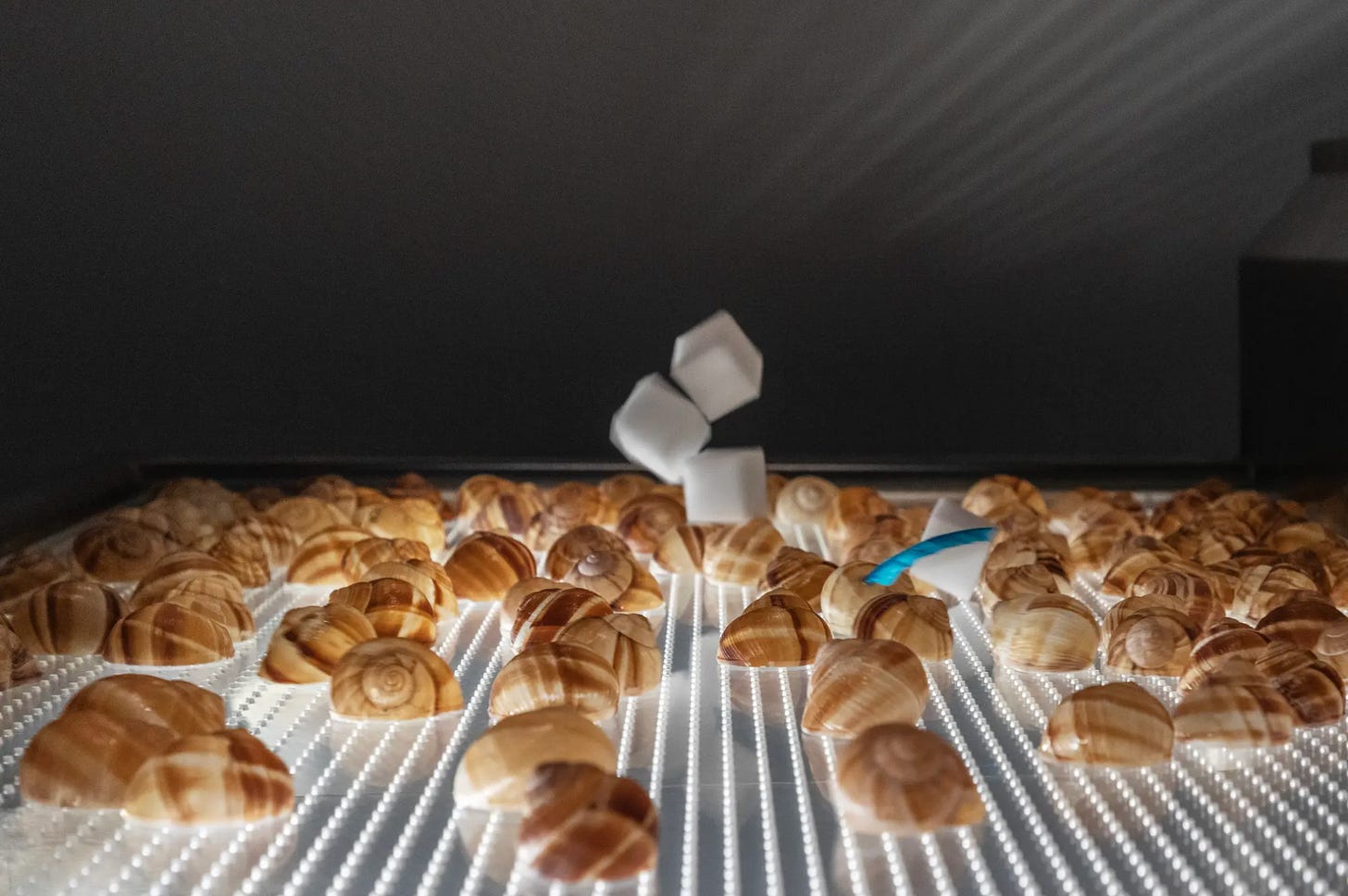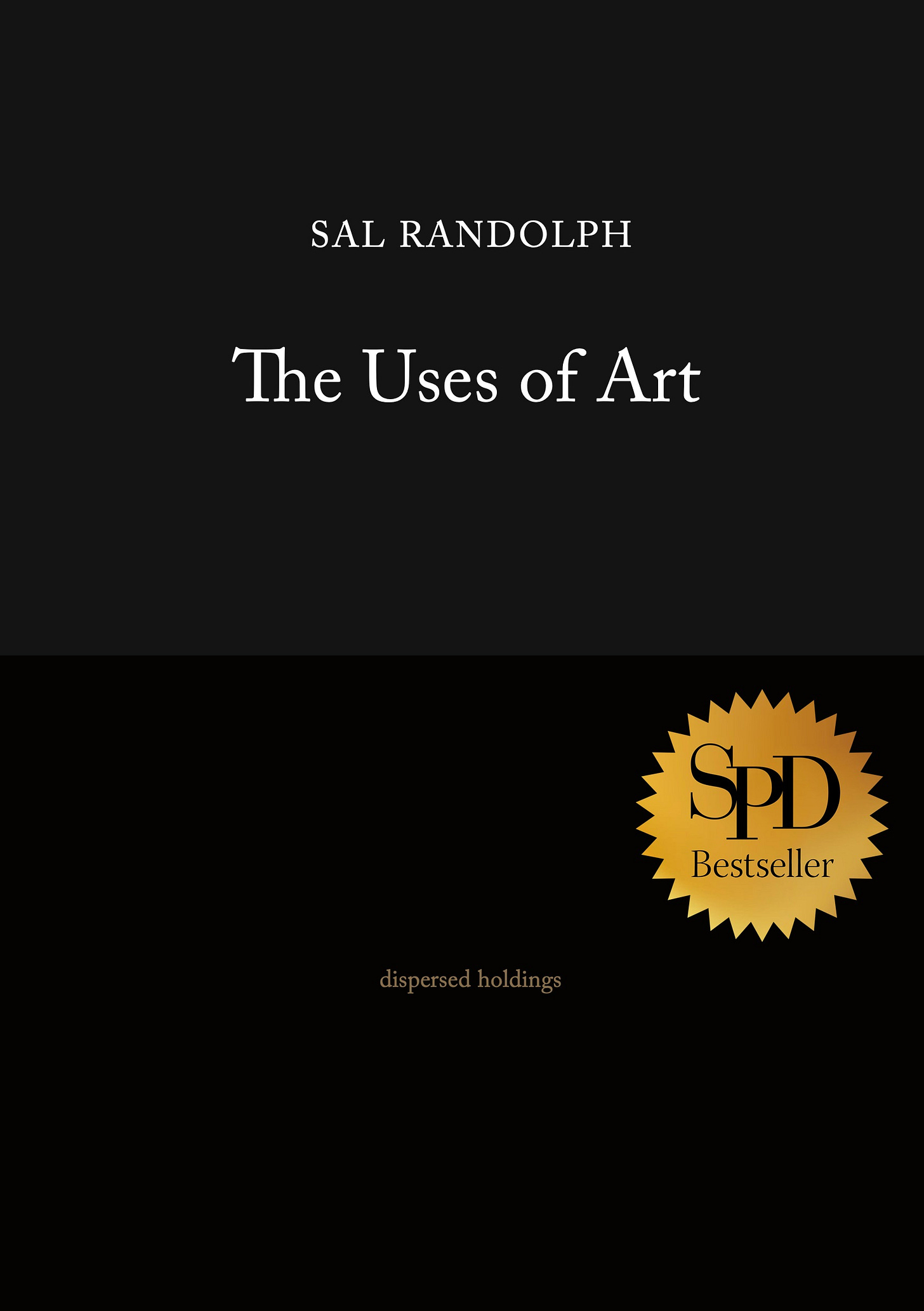Dear Friends,
I’ve been scribbling in the dark again, this time at the Queens Museum during a performance by the artist Aki Sasamoto. I was sitting on the floor next to Jeff — Jeff and I have been adventuring see Aki’s work together for years.
This week: two views of Aki Sasamoto’s Point Reflection, first one from my dear friend and fellow-traveler Jeff Dolven, and then one from me.
— Sal
Point Reflection - Jeff Dolven
Sal! Jeff here. Is it cheating to tell you about something we actually saw together? But since the rest of you weren't there: we went to the Queens Museum for Aki Sasamoto's "Point Reflection" on Sunday. A point reflection is a transformation in which every point is reflected across a specific fixed point).
e
•
ə
You enter through a gallery filled with restaurant-grade steam tables, which have had their trays replaced with a plexiglass sheet something like an air-hockey rink—perforated with a grid of little holes about a dime apart from each other, air forced upward through them. Across that pneumatic pillow skate dozens of whorled shells, colliding at random; mixed in among them, a few self-adhesive plastic hooks and empty sugar packets. Some of the shells have jaunty plastic feathers attached, which makes them spin with particular energy. Along the walls, whiteboards with various quasi-meteorological diagrams. A cooler along the wall has foam ice cubes in it, and a few of those cubes are also loose on the steam tables. Occasionally they take flight as high as a foot above the surface.
When you pass on, the staff finds you a seat, seated on the floor or a stool or standing against the wall. Three lengths of wide gray plastic pipe, maybe two and a half feet in diameter with a spiral patten on the outside, are arranged in front of us, with other segments standing against the far wall and over to the right, where there are also microphones and a couple of instruments, a saxophone and a clarinet on stands. Just in back of the three pipes is a long low table, shaped, from above, like an infinity sign or a pair of ski goggles. It will turn out to be an air table, too.
Aki comes out now, in her signature jumpsuit, straps on a headlamp, and crawls into one of the pipes, almost on her belly. One of the two musicians (a woman and a man) comes over to help align the pipes, so she can crawl from one to the other, the starts to rearrange them, making an ad hoc maze. Partway into one segment, Aki rears up, so she is now a pipe on legs, her headlamp shining out the top. She swings around in perplexity as voices urge her to go left, go right, go left left left. Finally she reaches the far wall, shimmies out, and then climbs up on top, sitting precariously on the rim and addressing the audience. What she says is somewhere between a rumination, analysis, and a lecture—beginning with the surprise of encountering a counterclockwise snail (which paired with a clockwise snail makes for a point reflection), and taking up questions of scientific knowledge, what can be learned statistically and what can or cannot be proven. With all the air currents around, the shells whorling like hurricanes, the climate is in the air. After a while she steps onto the table, which activates with forced air from below—she tries to sleep in a billowing sheet, and the foam ice cubes dance around her. My recollections get a little less precise from there—more talk about the snails, and the weather, and more music from the two musicians, singer and saxophonist. Finally, the three of them sit down behind a length of pipe that has become a counter in a coffee shop. Aki is the barista, and the other two make demands for increasingly specialized, complex, even paradoxical espresso drinks (“a sixteen ounce latte, and could you put that in a four ounce cup?”). She has a box of miscellaneities under her makeshift counter, and she fills coffee cups with those odd objects and with little lights, so that the to-go caps glow like lanterns. She positions them around the musicians and then the piece is over.
Point Reflection - Sal Randolph
The Beautiful Absurd
Why do I love Aki Sasamoto’s work? Why does it tickle me in a place nothing else does?
There’s an episode of the Dick Van Dyke Show which aired in 1964. In it, Laura Petrie (Mary Tyler Moore) goes to a kind of experimental theater performance, a play called Waiting for an Armadillo. What we see of the play is absurd — a TV satire version of something like Becket’s Waiting for Godot — but I love it too.
We’re watching Laura, sitting in the audience in a folding chair waiting for the play to begin, when a man in a track suit enters trotting down the aisle and carrying a watermelon in his arms. He declaims, “Yes, no, yes no! Is the world ready for me?” After a pause for some sitcom dialogue he says: “Up! Down! Yes! No! Shall I stay or shall I go?” “Go!” says a man’s voice from the invisible stage. The man turns and trots out.
The play goes on for a few more lines, but everything is really contained in that moment: the goateed performer cradling a very large watermelon, speaking his lines with total seriousness.
Aki Sasamoto’s work is absurd in a way that hovers between the Dick Van Dyke show and the existential. She’s sincere, but she signs her emails “Sincere cappuccino.”
Aki Sasamoto is an artist who creates installations which come to life when she performs in them. She began as a dancer, so her work has an intensely physical energy. Her performances feel a little like lectures, a little like stand-up, but in between stories or bits she typically gives herself unnecessarily arduous tasks to perform, using elements of the installations as props.
I think of her as Aki (rather than “Sasamoto”) because I’ve spent some time with her, and so has Jeff. You can find the story in my book The Uses of Art.
Five Things About Aki Sasamoto
1. Aki’s first medium is struggle — her installations are obstacle courses. She never makes anything easy for herself. If she did, there would be no performance, no art. Her second medium is dilemma. Each piece of Aki’s catches her in a divided moment, yes or no, this way or that.
2. Aki’s work is built around images and stories. You see a body crawling though ventilation tubes wearing a headlamp. She tells you about the rare snail, the one whose shell spirals counterclockwise, exposing the possibility of being different. As in a dream, pairs of bedroom slippers are animated by wind rushing through the perforated surface of the platform she’s tossing and turning on. A few minutes later, she becomes a person desperately responding to a stream of contradictory and impossible coffee orders by handing out cups brimming with light.
3. Aki thinks of the objects in her installations and performances as characters; they are also actors, or cast-members. In one interview she talks about auditioning them. In an Instagram video, Aki explains: “So, the sponges are partygoers, and the snails turn counterclockwise because they are clockwise, you know? And there goes more characters!”
4. Aki reveals the title, Point Reflection, in a story about a grade-school teacher who could simultaneously draw a figure with one hand and its perfect reflection with the other. Apparently the teacher did this to entertain the class — symmetrical figures appearing precisely under her hands with a kind of uncanny magic. In Aki’s wobbly and imperfect version, she wields squeaky markers to mark one of the ventilation tubes with a pair of snails spiraling in opposite directions.
5. When speaking, she is usually lecturing, even when she’s telling a story. What she is saying seems at once meaningful and absurd. She tells us she can feel a mid-life crisis coming towards her with its familiar tropes. She calls it “the expected unexpected.” Is it possible to veer aside from impending fates like this? What if she is the snail whose shell spirals the wrong way? Would this be a kind of freedom? Or would the snail be unable to mate, would it be eaten by a snake?
There are moments where Aki seems to be offering the answer to life, but the flashes of understanding dissipate and fragment. They blow into the air like her foam cubes. In the end, I look into my hands and find only questions.
Aki Sasamoto
The exhibition Aki Sasamoto: Point Reflection is on view at the Queens Museum in New York through April 7, 2024
Aki Sasamoto at Bortolami Gallery
You can also see a conversation with Aki Sasamoto and Cassie Packard about Point Reflection here.
Jeff Dolven
Jeff Dolven is a poet and a scholar of poetry in no particular order. His poems have appeared in The Paris Review, The Yale Review, The New Yorker, and elsewhere, and in two collections, *A New English Grammar and Speculative Music; his books of criticism include Senses of Style and In Other Words. He teaches at Princeton University and is an editor-at-large at Cabinet magazine.
Waiting for an Armadillo
Further adventures with Jeff Dolven and Aki Sasamoto can be found in my book, The Uses of Art.
Artist Sal Randolph’s THE USES OF ART is a memoir of transformative encounters with works of art, inviting readers into new methods of looking that are both liberating and emboldening.
Dazzlingly original, ferociously intelligent.
— Michael Cunningham
A joyful, dazzling treasure-box of a book.
— Bonnie Friedman
Here’s a guide, to waking up, over and over again.
— Roshi Pat Enkyo O’Hara










I had this one saved and finally had a moment to read it. It took going all the way to Puerto Rico! Great to have 2 pairs of eyes to see the performance thru. And those 2 video clips were very much appreciated. I was going to look up the Dick Van Dyke one, it made me so curious to see what an early 60s mainstream comment on absurdity might look like. As for the other…hope I don’t have to wait as long to see it as I did to read this piece.
This was fascinating, and I enjoyed both videos very much. I loved the part in the interview where she suddenly realised that it sounded like she was an alcoholic! The performance you both described so well gave rise to lots of great phrases such as 'What she is saying seems at once meaningful and absurd'. I do value these direct responses to artwork or artists I would not otherwise have access to. Thanks!